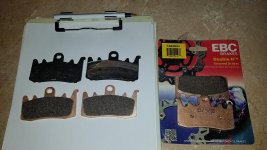I'm looking to upgrade my braking system for more stopping power than the OEM system which is already pretty good). I've read several threads on SL having to do with brake pad replacement mostly, plus tech articles from different sources and descriptions at the EBC website https://ebcbrakes.com/ebc-brake-pad-selector-tool/
My understanding is as follows;
Most modern motorcycles come equipped with organic or semi-sintered pads. I'm not sure which the Spyder comes with from the factory. The organic is the softest, cleanest type but has relatively short life and the least stopping power. The semi-sintered contains some metal (about 30% for EBC) and may be steel or copper typically (EBC uses copper). These have greater stopping power and longer life than organic at the cost of more brake dust and greater rotor wear.
The fully sintered pads (HH series for EBC) have the greatest stopping power and longest life, but will seriously shorten the life of standard rotors. Hence, going to fully sintered pads usually is combined with new stainless steel rotors that can handle the pads' higher friction, wear and heat. These rotors are also 'floating' which allows some expansion without causing warpage of the rotor. A full set of EBC front and rear HH pads and rotors runs about $500 currently.
Comments, corrections or criticisms?
My understanding is as follows;
Most modern motorcycles come equipped with organic or semi-sintered pads. I'm not sure which the Spyder comes with from the factory. The organic is the softest, cleanest type but has relatively short life and the least stopping power. The semi-sintered contains some metal (about 30% for EBC) and may be steel or copper typically (EBC uses copper). These have greater stopping power and longer life than organic at the cost of more brake dust and greater rotor wear.
The fully sintered pads (HH series for EBC) have the greatest stopping power and longest life, but will seriously shorten the life of standard rotors. Hence, going to fully sintered pads usually is combined with new stainless steel rotors that can handle the pads' higher friction, wear and heat. These rotors are also 'floating' which allows some expansion without causing warpage of the rotor. A full set of EBC front and rear HH pads and rotors runs about $500 currently.
Comments, corrections or criticisms?
Last edited:

